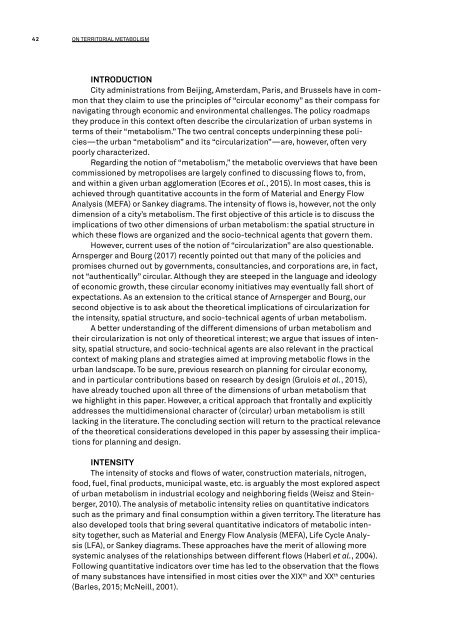DESIGNING TERRITORIAL METABOLISM
978-3-86859-489-8 https://www.jovis.de/de/buecher/product/designing_territorial_metabolism.html
978-3-86859-489-8
https://www.jovis.de/de/buecher/product/designing_territorial_metabolism.html
Create successful ePaper yourself
Turn your PDF publications into a flip-book with our unique Google optimized e-Paper software.
42 ON <strong>TERRITORIAL</strong> <strong>METABOLISM</strong><br />
INTRODUCTION<br />
City administrations from Beijing, Amsterdam, Paris, and Brussels have in common<br />
that they claim to use the principles of “circular economy” as their compass for<br />
navigating through economic and environmental challenges. The policy roadmaps<br />
they produce in this context often describe the circularization of urban systems in<br />
terms of their “metabolism.” The two central concepts underpinning these policies—the<br />
urban “metabolism” and its “circularization”—are, however, often very<br />
poorly characterized.<br />
Regarding the notion of “metabolism,” the metabolic overviews that have been<br />
commissioned by metropolises are largely confined to discussing flows to, from,<br />
and within a given urban agglomeration (Ecores et al., 2015). In most cases, this is<br />
achieved through quantitative accounts in the form of Material and Energy Flow<br />
Analysis (MEFA) or Sankey diagrams. The intensity of flows is, however, not the only<br />
dimension of a city’s metabolism. The first objective of this article is to discuss the<br />
implications of two other dimensions of urban metabolism: the spatial structure in<br />
which these flows are organized and the socio-technical agents that govern them.<br />
However, current uses of the notion of “circularization” are also questionable.<br />
Arnsperger and Bourg (2017) recently pointed out that many of the policies and<br />
promises churned out by governments, consultancies, and corporations are, in fact,<br />
not “authentically” circular. Although they are steeped in the language and ideology<br />
of economic growth, these circular economy initiatives may eventually fall short of<br />
expectations. As an extension to the critical stance of Arnsperger and Bourg, our<br />
second objective is to ask about the theoretical implications of circularization for<br />
the intensity, spatial structure, and socio-technical agents of urban metabolism.<br />
A better understanding of the different dimensions of urban metabolism and<br />
their circularization is not only of theoretical interest; we argue that issues of intensity,<br />
spatial structure, and socio-technical agents are also relevant in the practical<br />
context of making plans and strategies aimed at improving metabolic flows in the<br />
urban landscape. To be sure, previous research on planning for circular economy,<br />
and in particular contributions based on research by design (Grulois et al., 2015),<br />
have already touched upon all three of the dimensions of urban metabolism that<br />
we highlight in this paper. However, a critical approach that frontally and explicitly<br />
addresses the multidimensional character of (circular) urban metabolism is still<br />
lacking in the literature. The concluding section will return to the practical relevance<br />
of the theoretical considerations developed in this paper by assessing their implications<br />
for planning and design.<br />
INTENSITY<br />
The intensity of stocks and flows of water, construction materials, nitrogen,<br />
food, fuel, final products, municipal waste, etc. is arguably the most explored aspect<br />
of urban metabolism in industrial ecology and neighboring fields (Weisz and Steinberger,<br />
2010). The analysis of metabolic intensity relies on quantitative indicators<br />
such as the primary and final consumption within a given territory. The literature has<br />
also developed tools that bring several quantitative indicators of metabolic intensity<br />
together, such as Material and Energy Flow Analysis (MEFA), Life Cycle Analysis<br />
(LFA), or Sankey diagrams. These approaches have the merit of allowing more<br />
systemic analyses of the relationships between different flows (Haberl et al., 2004).<br />
Following quantitative indicators over time has led to the observation that the flows<br />
of many substances have intensified in most cities over the XIX th and XX th centuries<br />
(Barles, 2015; McNeill, 2001).


















